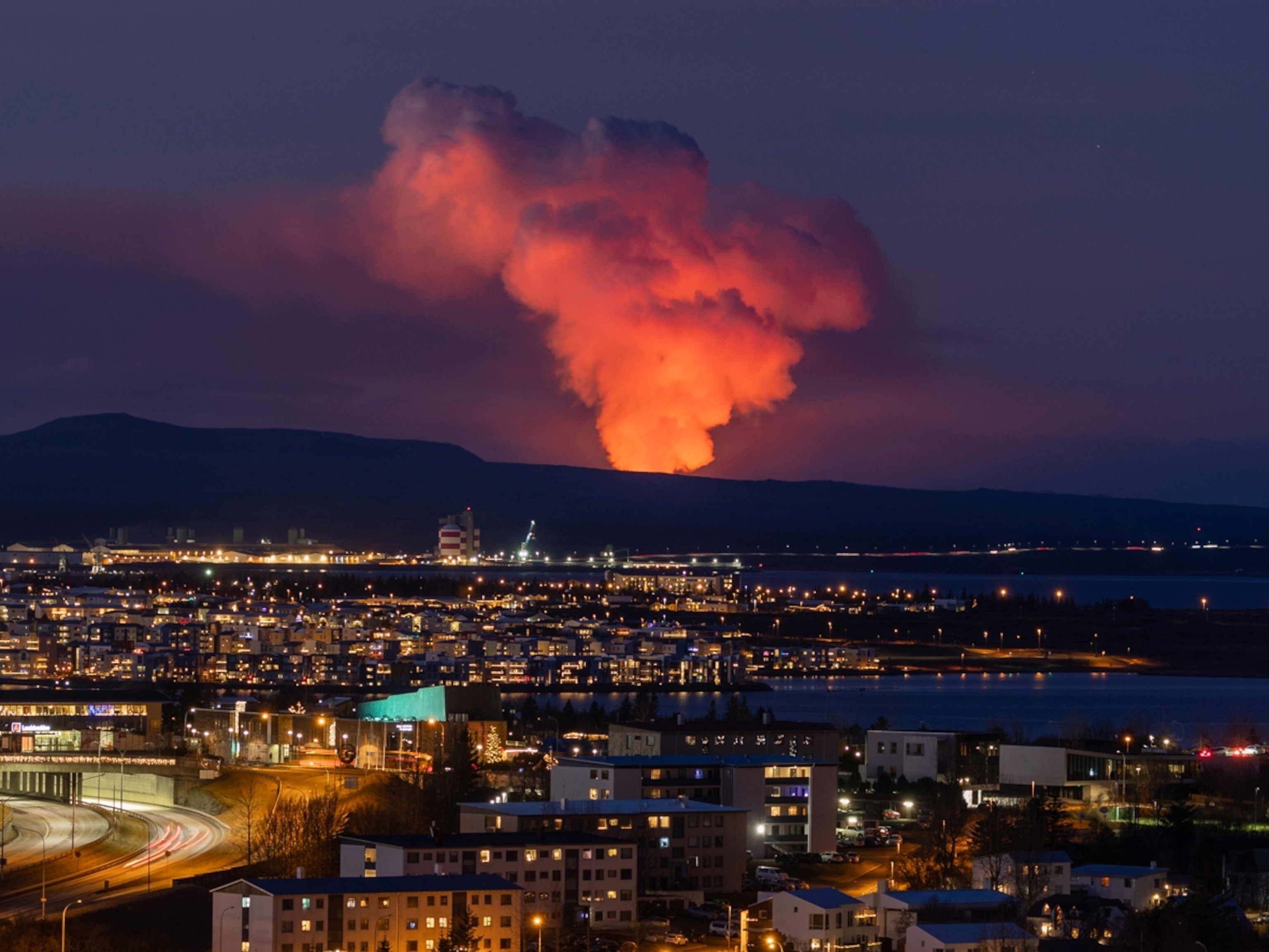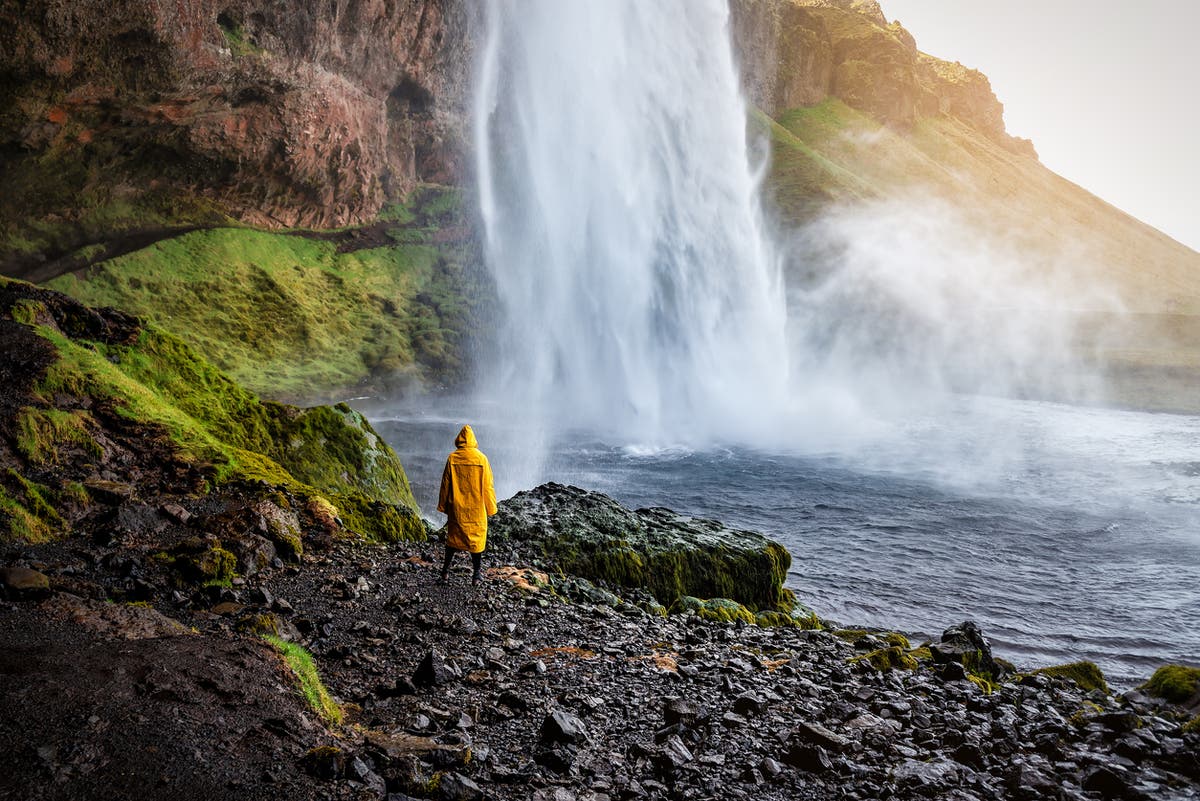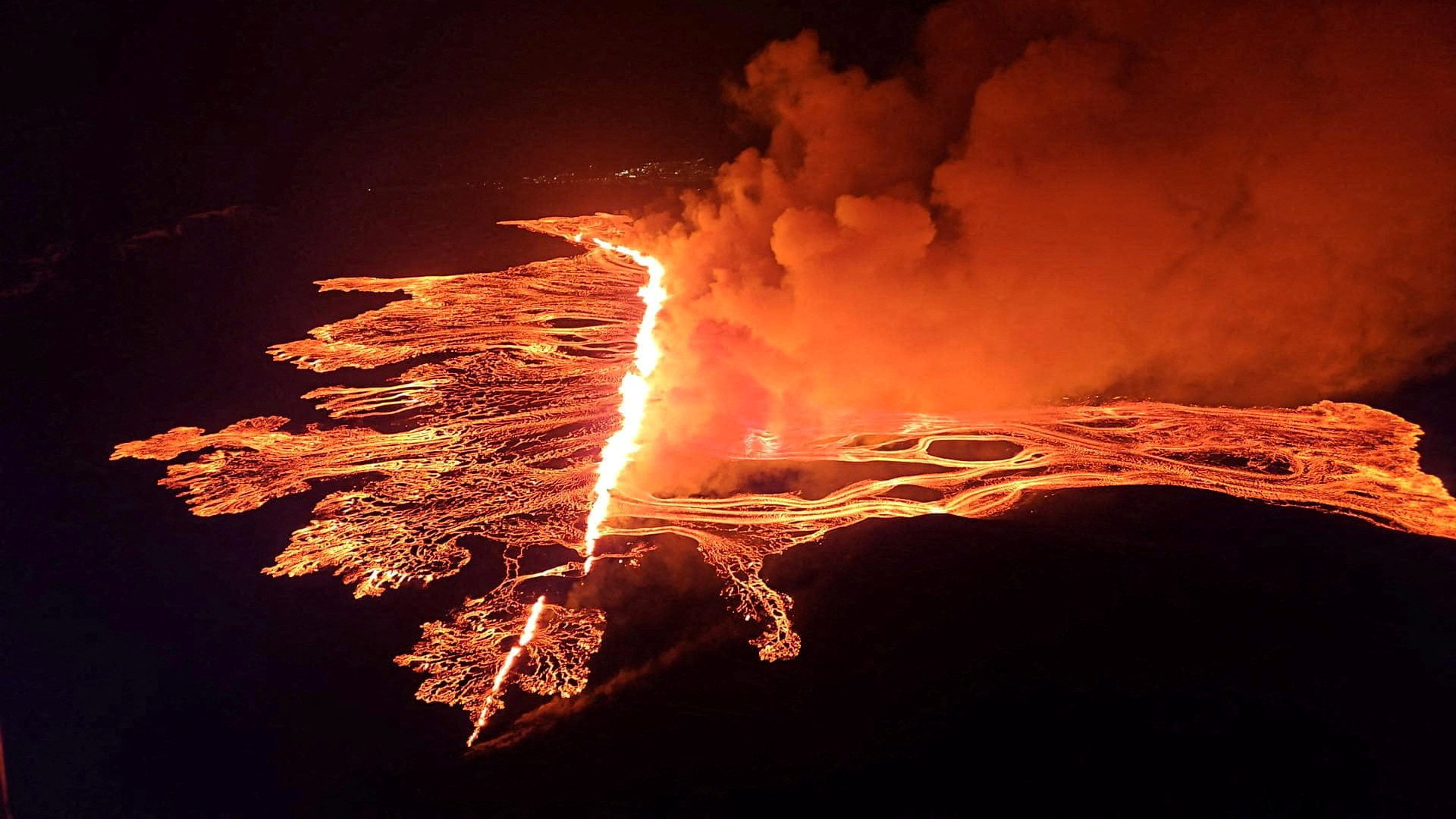Volcanic Activity In Iceland
Startling volcanic activity has town in Iceland bracing for crisis
Scientists believe a large pocket of magma has risen below Grindavík, threatening to flood the coastal town with molten rock and generate explosive blasts if lava reaches the sea.

Residents of the town of Grindavík in southwestern Iceland were briefly allowed to return to their homes to collect essential items after being told to evacuate amid rising concerns about a possible volcanic eruption.
PHOTOGRAPH BY BRYNJAR GUNNARSSON, AP PHOTO
The Reykjanes Peninsula in southwest Iceland is no stranger to volcanic outbursts. The emergence of lava into a remote valley in March 2021 marked the first eruption on the peninsula in eight centuries—and there have been two additional eruptions since. A fourth was considered inevitable, and researchers hoped that it would be yet another relatively safe eruption far from population centers.
Now it seems those hopes have been dashed. An intense series of earthquakes starting in late October reached a zenith last Friday when seismic activity migrated toward the coastal town of Grindavík, home to 3,500 people. Experts believe a large volume of magma has risen just below the town, prompting a speedy evacuation.
Volcanologists believe the chance of an eruption is very high, and they worry a profusion of lava could flow directly into the town or adjacent to it. “The coming days are filled with uncertainty,” says Tom Winder, a volcano seismologist at the University of Cambridge.
There is still a small chance that the magma fails to find a route to the surface, resulting in no eruption. A worst-case scenario, though, would involve the destruction of the town, accompanied by explosive, ash-producing bursts just offshore if lava hits the sea.
“My reaction has been so far mostly emotional distress rather than scientific curiosity,” says Evgenia Ilyinskaya, a volcanologist at the University of Leeds, who grew up in Iceland. “I still can't imagine what it's like leaving your home in the middle of the night not knowing if you'll see it again.”
A magmatic reawakening
The volcanic eruptions in Reykjanes Peninsula these past couple years are widely thought to represent a new era of activity. Last time the region flared up, between 1210 and 1240, there were several eruptions as multiple fissures sporadically opened and let molten rock loose—a period known as the Reykjanes Fires.
Afterwards, no lava reached the surface of the peninsula until March 19, 2021: After 15 months of increasingly intense and frequent quakes, fissures appeared near Fagradalsfjall, a volcanic mountain. The fierce eruption, featuring prolific fountains and rivers of runny lava, took place in a valley several miles from the nearest structures.

That eruption ended six months later, and it was followed by a second, smaller eruption to the northeast in August 2022, which lasted for three weeks. A third fissure burst, again to the northeast, in July of this year, releasing an eruption that lasted almost a month. By this stage, volcanologists were confident that the peninsula was in a sequel of sorts to the Reykjanes Fires, a new multidecadal period of sporadic fissure eruptions.
Scientists suspected that the next eruption would follow a similar precursory pattern to the past three: lots of earthquakes as magma breaks through rock on its way to shallow parts of the crust, accompanied by the ground changing shape to accommodate the shifting magma.
The location of the fourth eruption, too, was expected to be in the same area near Fagradalsfjall, where the ground inflation was focused. But the recent spike in quakes suggested magma was on the move—not necessarily to the surface, but horizontally below ground. This time, things looked different.
The ground deformation was more dramatic, suggesting the rate of magma flow was at least twice as high as during the past three eruptions. Worryingly, the location of all this geologic activity was not near Fagradalsfjall, but close to Þorbjörn, a mountain close to the Blue Lagoon spa—a tourist hotspot—Grindavík, and the Svartsengi geothermal power station.
An eruption here could threaten any of these locales. “The location of this episode of activity being at Svartsengi caught many people by surprise,” says Winder.
The reason magma headed in this direction rather than following the pathway of the past three eruptions is unclear. The deep magma caches here have at least two routes to the surface, says Þorvaldur Þórðarson, a volcanologist at the University of Iceland. But “why they operate semi-independently is a conundrum.”
Crisis mode
There have been several periods of ground inflation beneath Þorbjörn in recent years, suggesting magma was accumulating or shifting about below. But on each prior occasion, the inflation ended, and magma didn’t rise to the surface. “I was expecting this to blow over as usual,” says Edward Marshall, a geochemist at the University of Iceland.
Nevertheless, preemptive evacuation plans were drawn up for Grindavík, while workers took steps to ensure the power plant—critical for the region, especially during the winter—could be operated remotely. On November 9, the increasingly severe earthquakes also forced the Blue Lagoon to temporarily close its doors and move its guests elsewhere.
Then, during the afternoon of November 10, “things went crazy,” says Winder. A huge jump in seismic activity saw the peninsula shake, with a handful of magnitude 4 or higher earthquakes causing damage to roads and some buildings. By this stage, 24,000 quakes had struck the peninsula since late-October.
Magma was now rapidly ascending—and the change from mildly concerning inflation to a sheet of magma blasting upward through old geologic layers (known as a dike) stunned scientists. “I was staggered by the speed of the transition,” says Winder.
A state of emergency was declared, and by early Friday evening, the Icelandic Meteorological Office forecasted that an eruption would happen in the coming days. “The sudden injection of a dike was a game changer,” says Marshall—that molten rock now had a viable pathway to the surface. Based on the straining crust, it’s possible that a huge volume of magma, greater than the past three eruptions, was involved.
Experts originally thought any eruption would most likely occur around old craters to the city’s northeast—an area of weaker ground that magma could exploit. But things took a turn for the worse when, late on Friday, the seismic rumblings migrated toward Grindavík itself—meaning an eruption may take place close to, or directly within, the town.
Close to midnight that day, the government ordered a mandatory and immediate evacuation, which was completed roughly two hours later. That night, the seismic activity extended out to sea. An eruption here “would generate a lot of ash and hazardous gases as well as steam, and more explosive activity,” says Mike Burton, a volcanologist at the University of Manchester.
If this occurs, it would most likely remain a danger localized to Iceland, not an international issue akin to the 2010 Eyjafjallajökull eruption—an eruption below an ice cap that created a colossal, long-lived ash column that temporarily shut down a swath of Europe’s airspace.
By the evening of November 11, the magma was less than half a mile from the surface, and the corridor of a possible eruption site had grown to roughly 10 miles long, extending from the cratered region, through Grindavík, to a short distance offshore.
An anxious wait
By Monday, the seismic activity had become less intense. But that doesn’t mean an eruption is less likely—it could suggest the opposite.
The seismic activity dropped off somewhat prior to the last three eruptions, suggesting that magma didn’t need to break rocks apart so forcefully as it neared the surface. But the peninsula has also experienced at least one failed eruption in the past few years, when a magma intrusion tried but failed to break out above ground.
The 2021 outburst at Fagradalsfjall began three weeks after the magma supplying it rose to shallow parts of the crust. It could also be weeks, not days, before Grindavík sees an eruption, “so the residents of Grindavík might need to get comfortable” sheltering elsewhere, says Marshall.
An eventual outburst could feature lava pouring out of a segment of that corridor, or molten rock could gush across the entire line. “Some of the worst-case interpretations of the data are suggesting an order of magnitude larger than Holuhraun,” says Ilyinskaya, referring to the 2014 and 2015 Icelandic eruption that covered 33 square miles of land in lava—roughly the size of Manhattan Island. But unlike this upcoming paroxysm, that eruption was in a remote location.
There is also a small chance that no eruption will be forthcoming. That would be a surprise to scientists, and a relief to those in Iceland—but tensions will remain, with many wonderings why all that geologic turmoil resulted in a misfire.
Most experts are betting that fresh lava will make an appearance. The Icelandic Meteorological Office considers the likelihood of an eruption in the coming days “significant,” and Icelandic authorities and scientists, working around the clock to preserve lives and infrastructure, are hoping for the best while preparing for the worst.
“I think we have to expect unexpected behavior,” says Burton.
Source
https://www.nationalgeographic.com/science/article/startling-volcanic-activity-town-in-iceland-bracing-for-eruption-crisis
https://www.nationalgeographic.com/science/article/iceland-reykjanes-peninsula-fourth-volcanic-eruption
https://www.theguardian.com/world/2023/nov/18/threat-volcanic-eruption-iceland-grindavik-reykjanes-peninsula
https://uk.news.yahoo.com/iceland-volcano-live-shock-images-034943354.html
https://www.bnnbloomberg.ca/iceland-braces-for-volcanic-eruption-that-could-wipe-out-town-1.1997584

























